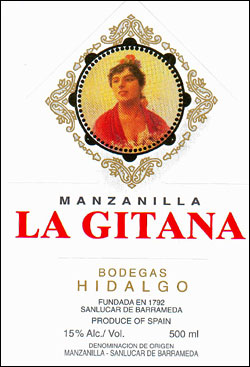Every wine book for beginners devotes some space to sherry, so we all know that sherry is one of the world’s great wines. But how many of us ever drink the stuff? Oh, we may order a quarter-liter at a tapas bar just to get into the sheer Spanish spirit of the thing, but how about on other occasions? More important, how many of us ever buy a bottle of sherry to enjoy at home?
I thought so. And until last week, I was pretty much with you: I thought of dry sherry as a thin, pallid, pinched potable, suitable only for thin, pallid, pinched Oxford dons to serve sweating students after a particularly probing tutorial. And one reason I thought so is that I believed sherry, like most fortified wines, would keep nicely for years if kept tightly corked. You thought so, too, didn’t you?
Well, we were both wrong. All the proof you need to overthrow all your ideas about dry sherry are contained in a modest little bottle widely available in Seattle wine shops. (Yes, I know, if it’s so widely available, somebody must be buying it already. But by the same token, they are already hip to dry sherry, so they have my permission to cut class this week, assuming they haven’t already. I’m not talking to them; I’m talking to you: You know who you are.)
To resume: For the modest investment of about $10 for a half-liter bottle, you can take home a sample of La Gitana manzanilla sherry, which I suspect will shake your wine world. Thin? La Gitana has a powerful, beckoning bouquet, reminiscent of the smell of subtropical underbrush baking in the sun. The nose carries over directly into flavor: firm, nutty, woody, austere but without a trace of bite. As soon as you swallow, your palate clears, ready for a nibblea roasted almond, a curl of dry Serrano ham, a grilled anchovy, perhapsbut the flavor stays resonating in your sinuses and nostrils, enfolding whatever you’ve eaten in a complementary halo of refreshing aroma.
Manzanilla sherry comes from just one place on earth, the Atlantic beachfront town of Sanlcar de Barrameda north of Cᤩz near the southernmost tip of Spain. The story of how dry sherry’s made is worth knowing, but is easily found in a good reference work like The World Atlas of Wine. What’s immediately important is that you pick up a bottle of La Gitana (it means “the gypsy girl”) before summer is quite over, that you chill it icy cold, that you pick up a few toothsome tidbits, and then invite a friend or two over for tapas: I guarantee it will, for an hour or two, make your deck a decent approximation of Andaluc�
La Gitana Manzanilla sherry, about $10 at The Spanish Table and many other fine wineshops. Produced by the Hidalgo family of Sanlcar de Barrameda, la Gitana is imported by Seattles Classical Wines, Ltd., which also carries almost a dozen other premium sherries ranging from an inexpensive Napole�cream (sweet) sherry for about $12 to the rare single-cask long-aged dry palo cortado at about $120 for a 750-ml. bottle. La Gitana is almost unique among Spanish sherries in bearing a date of bottling on its label to ensure freshness. Fino and manzanilla sherries are made to be drunk as soon as they emerge from the multiyear aging and blending process called the solera system. They should also be drunk immediately after opening, before their spunky freshness of flavor fades.
Other fine Spanish wines imported by Classical Wines, Ltd.:
2002 Lusco albari�about $18). From the misty northwest of Spain comes this noble dry white wine made from the native grape of the area (known as albarinho just across the Portuguese border to the south). Less dependent on bouquet than many whites and more on robust, chewy flavor, this is a wine that can stand on its own and stand up to grilled chicken or pork or strong-flavored whitefish like fresh sardines or anchovies. Available at Larrys Bellevue and other wine shops.
2002 Mart�ancho verdejo (about $12). Driven near commercial extinction by changing fashions (not to mention bad viticulture and winemaking), verdejo, the native white wine grape of Castile, is making a comeback among discriminating wine fanciers. With this one, the flowery bouquet doesnt prepare you for the gutsy, earthy flavor of this version from Angel Rodr�ez, who owns the 350-year-old vineyard from which most of todays fine verdejo vines derive. Available at Petes Bellevue and other wine shops.








